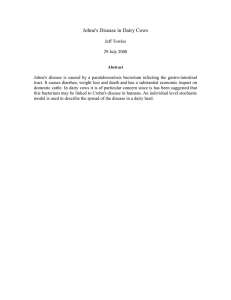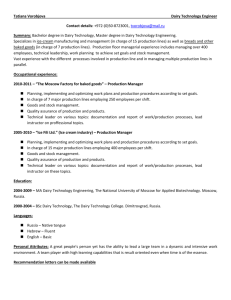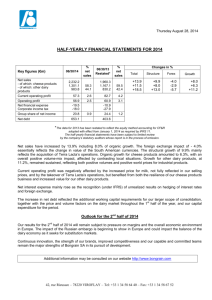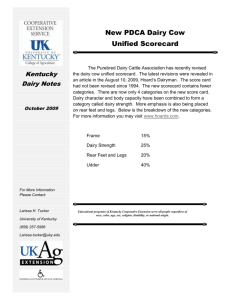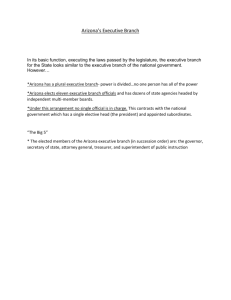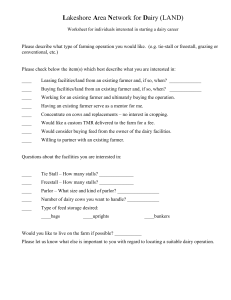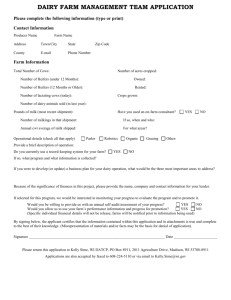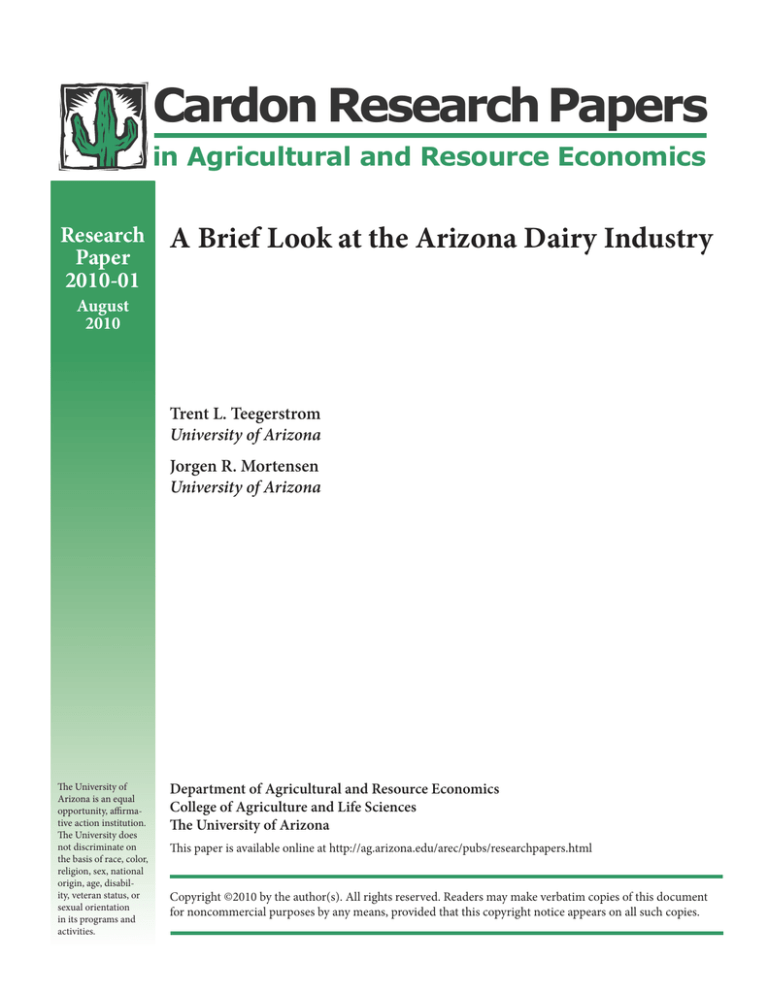
Cardon Research Papers
in Agricultural and Resource Economics
Research
Paper
2010-01
A Brief Look at the Arizona Dairy Industry
August
2010
Trent L. Teegerstrom
University of Arizona
Jorgen R. Mortensen
University of Arizona
The University of
Arizona is an equal
opportunity, affirmative action institution.
The University does
not discriminate on
the basis of race, color,
religion, sex, national
origin, age, disability, veteran status, or
sexual orientation
in its programs and
activities.
Department of Agricultural and Resource Economics
College of Agriculture and Life Sciences
The University of Arizona
This paper is available online at http://ag.arizona.edu/arec/pubs/researchpapers.html
Copyright ©2010 by the author(s). All rights reserved. Readers may make verbatim copies of this document
for noncommercial purposes by any means, provided that this copyright notice appears on all such copies.
A Brief Look at the
Arizona Dairy Industry
Trent L. Teegerstrom and Jorgen R. Mortensen
Department of Agricultural and Resource Economics
The College of Agriculture and Life Sciences
The University of Arizona
June 17th , 2009
A Brief Outline of the Arizona Dairy Industry
The purpose of this report is to give the reader a brief overview of the Arizona Agriculture
industry along with some general trends and economic information about the Arizona dairy
industry. This report should by no means be considered a complete analysis of the Arizona
dairy industry but the reader should gain some insight into the basic structure of the industry.
Figure 1 shows the changes in the Arizona Agricultural Revenues between 1990 and 2008.
During this period, market sales and government payments to Arizona’s agriculture show
some growth, (0.7% per year), after accounting for inflation. Lettuce, other vegetables and
melons, and dairy products have had the largest percentage gains over this period while
cotton and citrus have declined the most. Lettuce has replaced cotton as the crop with the
highest total sales value, due to the expanded production of winter lettuce in Yuma. Dairy
products also showed a significant annual growth, 4.7% per year.
Figure 1. Over the same periods of 1990 to 2008, Figure 2 shows that the Arizona’s total crop acreage
has been fairly stable since 1990 around 1 million acres. However, cotton acreage has
declined from 475,000 to 131,000 over this period. Pima cotton has almost totally
disappeared from Arizona with almost all production shifting to the San Joaquin Valley.
During this period, alfalfa acreage has increased by 100,000 acres or 51% going from 195 to
295 thousand acres. Feed grain acreage increased by an annual increase of 8.6%. The
increase has helped service our growing dairy industry and population. Vegetable acreage
has increased from 88 to 126 thousand acres from 1990 to 2008, reflecting the growth in
leafy vegetables during the winter season in Yuma.
Figure 2. Figure 3.
Source: National Agricultural Statistics Service Data Download, Arizona Dairy Industry Summary
Figure 4.
Source: National Agricultural Statistics Service Data Download, Arizona Dairy Industry Summary
The growth in the dairy industry and its need for additional feed can be shown with the
continued increase on the number of dairy cows in the state for the same time period. In table
3, we see that during the time periods of 1990 to 2008 the average number of dairy cows
increasing from 94,000 to 186,000 cows. While just looking at the average number of dairy
cows gives an indication of the need for additional feed it does not necessarily mean the
growth in the dairy industry. The next piece of information required is the milk production
per cow. Table 4 plots out the milk production per cow for Arizona during the periods of
1990 to 2008. Milk produced per cow, increases from 17,500 lbs in 1990 to 23,382 in 2008
or a 25% increase in production per cow, however during the period of 2003 to 2008
production remains flat.
The next set of figures look at the makeup of the dairy operation within the state examining
dairy farm producers both in numbers, size and concentration. First let’s look at the trend in
the number of operations. Figure 5 the shows the steady decline in the number of dairy
operations in Arizona from 290 dairies in 1993 to 180 dairies 2007. The majority of the
reduction in dairy numbers comes from the small to mid size dairies ranging from 1 to 199
head of cows declining from 300 to 105 operations in 2007. The larger dairies 200 + head
have remained relatively constant ranging from 100 operations in 1993 to 75 in 2007 (table
6).
Figure 5.
Source: National Agricultural Statistics Service Data Download, Arizona Dairy Industry Summary
Figure 6.
Source: National Agricultural Statistics Service Data Download, Arizona Dairy Industry Summary
Table 1 shows the concentration of farms by commodity in 2007. For the dairy industry,
approximately 49 farms accounted for 75% of all dairy commodities sold in Arizona.
Table. 1. Number of Farms Accounting for 75% of Commodity Sales 2007
Commodity
# of Farms and Ranches
% of all Farms and Ranches
Vegetable & Melons
48
1.91%
Fruit & Nuts
13
0.98%
Nursery/Greenhouse
18
6.41%
Cotton
29
9.63%
Cattle & Calves
55
1.35%
Dairy
49
25.79%
Source: 2007 Censes of Agriculture, National Agricultural Statistic Services
Estimation of Total Economic Impact from Dairy Production
The number of cows and the value of produced milk do not tell the whole story about the role
played by dairy farms. They also produce calves and cattle for feeding at other farms and for
slaughter, however
The economic impact does not stop at the farm level. Various milk processing industries in
Arizona owe their existence to in-state milk production. In the same way, a significant share
of the total cattle slaughter-house activity is based on animals from dairy herds.
Dairy farms, other farms feeding surplus dairy calves for slaughter, and dependent milk and
meat processing industries require means of production and various services for their
activity. These inputs are acquired from a great number of supply industries. And the effect
spreads like rings in water from first-round supply businesses to their suppliers, and so on
Further, to assess the full economic impact based on dairy farm production one must take
into account the activity that is induced by private spending of personal incomes earned by
employees and business owners in the agro-industrial complex of farms and milk and meat
processing businesses.
Statistics exist on many of the direct activities in identifiable farms and processing
businesses. But the value of indirect effects spreading around in a large net of businesses on
the input supply side cannot be established right away. The same is true for the mentioned
induced economic effect generated by spending of incomes earned in the agro-industry.
Direct, indirect and induced effects make up the total economic impact on the Arizona
economy based on dairy farm production. The total impact can be captured in a so-called
input-output model. It provides a systematic and detailed mapping of purchases and sales
among about 400 individual industry groups in Arizona. Such basic transaction statistics
(latest for 2007) together with computer model software from the Minnesota IMPLAN Group
allow for making a model specifically for the dairy industry. The established dairy model
estimates the values of direct, indirect and induced effects, respectively, and shares of the
total impact can also be assigned to other groups of industries.
Value-added is the appropriate economic concept for estimating the total effects spreading
from dairy farm production to other industry activities. It avoids overlapping and double
counting of economic activity. Other bases can be used, for example the effect on
employment
Total value-added impact
In 2007, dairy farm production brought about $1,079 million worth of value added in the
Arizona economy. This is one-forth of total direct and derived employment impact based on
all agricultural production in the state. Value-added generated directly at farm level came to
$334 million dollars, and the activity was $220 million worth of value-added in the milk and
meat processing industries. The indirect value-added impact in supply businesses amounted
to $323 million while induced private consumption effects came to $203 million. That is,
only about 31 percent of the total value-added activity took place at farm level while 69
percent was the economic activity generated outside primary farms.
In other words: Every value-added dollar at farm level leads to additional $21/4 worth of
value-added in other sectors of the Arizona economy.
Figure 7
Total employment impact
In 2007, a total of 15,000 Arizona jobs, employees and business owners, had their basis in
the primary production at dairy farms; see Table 2. The input-output calculations show that a
little over one-third of the total employment was in farming so that one farm job creates the
basis for almost two jobs in other sectors of the economy.
Table 2. Total Employment Impact from Dairy Farm Production in Arizona, 2007
Number of Jobs*
Percent
Farms
5,174
34.5
+ Processing industries
2,298
15.4
= Direct impact agro-business
+ Indirect, other industries
7,445
4,395
49.9
29.4
+ Induced effect
3,094
20.7
14,934
100.0
= Total employment impact
* The number of jobs is not adjusted to full-time basis.
Impacts by industry groups
In addition to the shown distribution of impacts on the three categories (direct, indirect and
induced effects) the following two tables illustrate how different groups of businesses are
influenced by the activity at dairy and cattle farming and in its directly related processing
industries.
Value-added in other basic trades like manufacturing, mining and construction is
significantly influenced by the agro-industrial demand of production inputs, which appear in
the indirect impact column. Induced impacts, originating in private consumption by income
earners in the agro-industry, are generally weighted towards different service sectors in the
economy.
Table 3. Value-added Impact from Dairy Farm Production in 2007, Million Dollars
Industry group
Type of impact:
Direct
Indirect
Induced
Total
Dairy and cattle farms
333.7
333.7
+ Milk and cattle processing
219.9
219.9
= Agro-industry sector
553.6
553.6
Other manufacturing
51.3
4.3
55.6
Mining, construction, utilities
23.0
6.1
29.1
Trade, transport, warehousing
92.4
38.8
131.1
Finance, insurance, real estate, prof. services
54.9
49.8
104.6
Entertainm., education., health, other services
101.8
103.5
205.4
323.3
202.5
1,079.4
Total value-added impact
553.6
The same general pattern is found with regard to the distribution of total employment impacts
by type of impact and by industry groups.
Table 4. Employment Impact from Dairy Farm Production in 2007, Number of Jobs
Industry group
Type of impact:
Direct
Indirect
Induced
Total
Dairy and cattle farms
5,147
5,147
+ Milk and cattle processing
2,298
2,298
= Agro-industry sector
7,445
7,445
Manufacturing
1,247
50
1,297
Mining, construction, utilities
157
49
206
Trade, transport, warehousing
967
635
1,603
Finance, insurance, real estate, prof. services
468
268
736
1,557
2,091
3,647
4,395
3,094
14,934
Entertainment, education., health, other services
Total employment impact
* The number of jobs is not adjusted to full-time basis.
7,445

